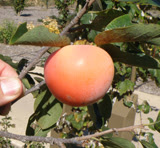Order came from
Raintree Nursery late last week. I kept them in the box in chilly shaded sheltered north location for 2 days. Planted some today. I expect this to be the last "big order". No doubt there will be small additions. This pretty much completes the mini orchard I planned.

Nicely packaged. Most are sizable trees. Raintree also had nice bonus plants, gave me a choice. Nice job.


I read not to be alarmed that persimmon roots are black. Sure enough, they are black. I read that the heartwood is also black. I won't live long enough to see that. This is
Nikita's Gift. A Ukranian hybrid between American and Asian Persimmons. I think it's 3/4 Asian and 1/4 American, not sure about that. Nikita does not require pollination. This was the smallest tree in the bundle.
 Saijo Persimmon.
Saijo Persimmon. Pic from Raintree. According to the catalog, this is the only Asian persimmon that can be relied on to fruit at the Raintree Nursery. I think they are higher altitude than here, and a little cooler. This variety is astringent until ripe. Saijo does not require pollination. Nice size whip - 5 ft tall, as thick as my ring finger.
 Sweetheart Sweet Cherry
Sweetheart Sweet Cherry. Pic from Raintree. Self pollinating sweet cherry. There may be flower buds on the tree. Would be nice, and quite unusual, to get a taste the first year.
 Vandalay Sweet Cherry
Vandalay Sweet Cherry. Pic from Raintree. Also self pollinating. Also appears to have flower buds on the tree. Most other sources don't show it looking so black - more wine red. If so that's OK.
There were also other items - grapes and a raspberry. Two pears. I heeled them in, in potting soil for the smaller items, and in my pile of leaf compost for the pears. They should do OK for a few days. Too tired to plant more.
Some small trees needed rearranging to plant these. I dug out my Petite Negri small tree and moved it up the hill, south of the house. It's now is a chicken wire root basket. I think the tunnelling animals ate a lot of the roots. I have some concern about that. Maybe the basket will help. Also, dug out a near dead or dead apple tree, unidentified size and type. In its place is one of the little jujubes. That made it possible to have the 2 new cherries next to 2 tart cherries in a 2X2 format. Even though none of them are said to require pollination, it's there if needed or helpful. The 2 persimmons are north and east of the rest of the trees, since they may grow larger. That way they wont shade other trees.
I planted volunteer lemon balm from the Vancouver house, next to these new trees. For honey bees, and beneficial insects, and maybe the flavor will deter some pest animals. Maybe.
 Rhubarb not quite ready for pie. Maybe 2 weeks.
Rhubarb not quite ready for pie. Maybe 2 weeks.
 The pink tree is "Hollywood Plum". There may yet be some frosts / freezes, in which case maybe no plums. I always think about that, this time of year.
The pink tree is "Hollywood Plum". There may yet be some frosts / freezes, in which case maybe no plums. I always think about that, this time of year.
 Side/Front yard. Spring is here. I'm impressed with the amount of diversity in this small space.
Side/Front yard. Spring is here. I'm impressed with the amount of diversity in this small space.























